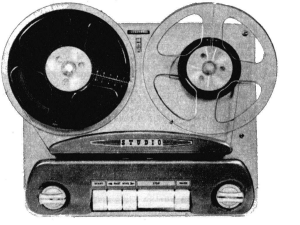This article was first
published
on CLUAS in September 2008
The Making of an Album, part 4: Editing, Mixing, Mastering and Duplication
Fourth of a four part guide to recording an album...
 Over the course of this series of articles we've been looking at the
cool stuff: hunting out studios,
searching for talented folk to produce and
engineer and going ahead with the actual recording. For bands the recording is,
obviously, by far and away the most rewarding part of the process. It's very
hands on and all involving. Once the recording is finished however the band have
to take a backseat and it's easy to feel as though the work is done and the
engineer is just crossing the t's and dotting the i's.
Over the course of this series of articles we've been looking at the
cool stuff: hunting out studios,
searching for talented folk to produce and
engineer and going ahead with the actual recording. For bands the recording is,
obviously, by far and away the most rewarding part of the process. It's very
hands on and all involving. Once the recording is finished however the band have
to take a backseat and it's easy to feel as though the work is done and the
engineer is just crossing the t's and dotting the i's.
In the next stage a certain amount of editing has to be undertaken. To give you
an idea about the work involved a typical list of things to do once the
recording is finished would include tidying the drum tracks, fixing any rogue
timing errors from an otherwise good take and compiling various different
overdub takes including vocals and tuning.
Most if not all recordings these days have areas that need tidying up. They
aren't mistakes as such but they wouldn't sound nice in the final recording. An
example would be the toms on a drum kit. The drummer might only hit these a
handful of times during a song but the tom will continue to resonate throughout.
As a result it's a good idea to delete all of the tom track where a tom isn't
hit. Also you might have a near perfect vocal take but there are a few minor
tuning problems. These can be easily fixed without turning the vocalist into
Cher.
The editing can be like watching paint dry but ultimately the end product will
benefit. Be aware though that sometimes it can be a little too easy to "fix it
in the mix". Keep focused during the recording, this will minimize critical
editing.
Once the engineer has tidied up the tracks s/he can get on with the mixing.
Again the location is all important but you don't need a 12 bedroom palatial
studio with cavernous live rooms. All that's needed is a decent control room.
Depending on the budget this can be anything from a project studio or mobile
set-up with a good set of speakers and a high spec digital audio work station
to a world standard studio with a desk the size of the bar counter in
Whelan's.
The best advice would be to make sure it's within your budget and that the
engineer is comfortable working there.
As we saw before a lot of the work is done in the recording stage, after all
that's when the performances are put down. During mixing however you will
realise that the songs are becoming just that. Songs. They take on a life of
their own.
In terms of the work involved the engineer starts to eq (equalise) the individual tracks to
make them sit with each other, taking the low end out of the guitars, for
example, will make the bass guitar be heard that little bit better. While 'eq-ing'
various other processes are brought in like compression, reverb , delays and any
funky effects that might suit the song and the overall album sound. This does
take time but the engineer is working hard and this will get the song to the
final stage of mixing, the levels. This is when the engineer and the producer
get together to give the song some dynamics, it could be something as small as
raising a guitar solo or something as big as raising the overall song level to
give the final chorus more impact. It's easy to sit back after the eq and
compression stage is set and admire the song, the levels though are the real
secret to giving your mixes some life.
What's important here is that you let the engineer take it to the levels' stage
on his/her own. I can tell you many stories of guitarists asking to raise their
guitars while the engineer is eq-ing the kick drum! The mix will get done quickly
and more efficiently if the band come in at the end. At this point the band can
either supervise the levels' stage or, if no producer is employed, they can get
fully involved.
So now you have your songs mixed. It's best to sit with them for a week or two
just in case you find something really bugs you such as a vocal being a touch
too low. It's also a good idea to figure out a running order. Be careful though,
it's at this point that there is a tendency towards not wanting to let go.
You've spent the last few weeks or months carefully crafting your masterpiece
and then all of a sudden it's finished and you have to let it go out into the
big bad world. Too many bands have hung on to their albums making minor change
after minor change until it either starts to sound overproduced or in
particularly bad cases it sounds dated because the vocal was recorded 2 years
previously! Make sure you are happy, but also let it go forth and multiply.
To properly let it go you have to send your album to be mastered. A lot of
mystery surrounds mastering for young bands as demos often get recorded and
never get to this stage. It a pretty technical process and needs the best
mastering engineer for your budget.
Why do you have to employ another engineer?
Well it's very important to have a fresh set of ears. They have not been
directly involved in the recording or mixing and can hear straight away if there
are tonal problems with the album. The mastering engineer's job is to eq and
compress the final mixes to make them sound like they are part of the one album.
They can also ensure your music sounds just as good on a small transistor
radio as it does on a stadium PA. They also take care of the song order on the
final CD. This takes time, patience and a very good set of ears. Ask your
engineer for recommendations before the album begins. Some of the best mastering
engineers are booked months in advance.
The mastering process will generally take around two days at most. It's not a lot
of time compared to what came before but it's massively important. The CD you
come out with at the end is the final master CD. It's your album finished and
ready to be packaged.
So that's it, the album is done. Your life's work up until this point is in
your hand. From this point you have to get it duplicated. Find a graphic
designer to make you up some fancy CD artwork and get it all off to the plant.
My only advice here is you get what you pay for. The cheaper it is per CD means
the poorer the duplication quality. The poorer the quality the more chance there
is of the final CD's having poorer sound quality or even wearing out prematurely.
So the basic mantra of this series is pay what you can afford, don't skimp, but
don't waste money on non critical areas. Take on board the creative influences
of the engineer and producer and most of all enjoy the process. What lies ahead,
hopefully, are weeks and months of promotion and gigging. You'll be longing for
those relaxing evenings after a long days recording while your chowing down on
your umpteenth service station breakfast roll!
Andy Knightley
This is the 4th and final part of 4 part series of articles on making an album. Check out the other articles:
The author Andy Knightley is a sound engineer who runs Krecording, which provides mobile recording and the facilities of Studio 57 in Dublin. He has recorded the likes of Sinead O'Connor, Bell X1, Damien Dempsey, Lir, Ronnie Drew (RIP), The Rags, Pilotlight, Le Galaxie/66e, Vasco Junior and Michele Ann Kelly. If you have any questions for Andy, feel free to contact him at info@krecording.com
